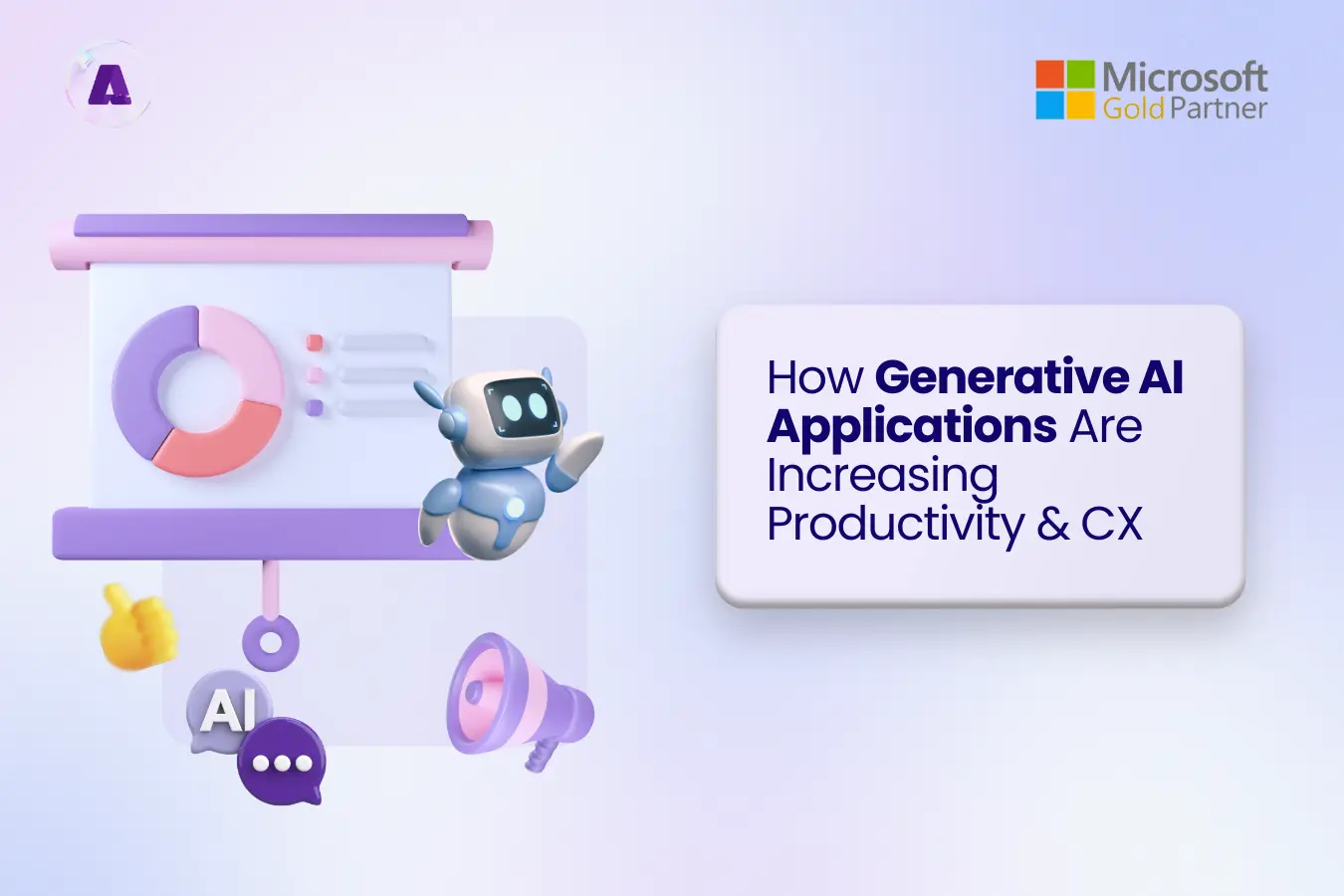
Introduction
Generative AI tools like ChatGPT, GitHub Copilot, and Stable Diffusion are taking the world by storm, and honestly, it’s easy to see why. These generative AI applications aren’t just for techies—they’re for everyone. They let us create, communicate, and even have a chat with a bot that feels almost human. Sure, they can handle the usual tasks like organizing data, but it’s their ability to write, compose music, and create digital art that’s getting all the buzz.
As this technology evolves, businesses and individuals alike are grappling with how generative AI fits into the bigger picture. In today’s fast-paced business world, delivering an exceptional customer experience is more important than ever. It’s no longer just a nice-to-have; it’s the key to standing out. With AI at the helm, it’s become more of a necessity than a luxury—transforming the way we work, communicate, and create unforgettable experiences.
Beyond creating amazing customer experiences, generative AI is also a productivity booster. It can automate routine tasks, analyze data faster, and even assist in brainstorming creative ideas—freeing up valuable time for teams to focus on what really matters. When it comes to customer service, this technology is a game-changer. AI-powered chatbots can handle basic inquiries, troubleshoot common issues, and provide instant support, allowing human agents to focus on more complex tasks that require empathy and expertise. This shift not only speeds up response times but also improves overall efficiency. In fact, according to Gartner by 2026, 50% of customer service and support organizations will have implemented GenAI-driven virtual assistants (VAs) for tasks like agent assistance and customer-facing interactions.
So, how exactly does Generative AI enhance the customer experience and ramp up productivity? How has this technology shifted the way businesses connect with their customers and create memorable interactions?
Let’s dive into this blog and explore how generative AI applications are transforming both productivity and customer experience, and why it’s becoming an essential technology for businesses in today’s competitive world.
Generative AI’s Impact on Productivity
Generative AI applications are transforming the workplace, streamlining operations, enhancing collaboration, and boosting productivity. Here’s how it’s making a difference across various tasks:
- Enhanced Communication & Teamwork
- AI-driven tools help teams communicate more efficiently by automating routine messages and facilitating smoother information sharing. This helps maintain alignment without the clutter of constant back-and-forth.
- Example: Slack’s AI tools help automate reminders and organize conversations, allowing teams to focus on more critical tasks.
- Smart Meeting Coordination
- Scheduling meetings becomes effortless with AI, which analyzes calendars, time zones, and availability to find the best meeting slots and prioritize deadlines.
- Example: Cortana intelligently schedules meetings and helps manage time zones, ensuring meetings are arranged at the most convenient times for all participants.
- Automating Routine Tasks
- AI’s ability to handle repetitive tasks such as sorting emails, managing appointments, or updating project statuses frees employees to focus on higher-level responsibilities.
- Example: Zapier automates tasks by connecting various apps, such as transferring form data into a spreadsheet automatically.
- Content Creation & Refinement
- Generative AI accelerates writing by drafting content, improving grammar, and ensuring clarity. This reduces the time spent on content creation and minimizes errors.
- Example: Grammarly refines written content by suggesting improvements in tone and clarity, while Jasper AI generates blog posts and articles faster.
- Efficient Data Handling
- AI automates repetitive data entry and performs in-depth analysis on large datasets, minimizing errors and saving time. This boosts the productivity of data-driven tasks.
- Example: UiPath automates tasks like data entry and document parsing, improving accuracy and freeing employees from tedious work.
- Project Oversight & Optimization
- AI simplifies project management by automating task assignments, tracking progress, and offering insights to optimize resource allocation, ensuring smooth project execution.
- Example: Monday.com utilizes AI to monitor timelines, suggest task assignments, and predict project delays, keeping projects on track.
- Data-Driven Strategy & Planning
- AI enhances decision-making by analyzing large amounts of data and uncovering valuable insights, empowering businesses to make more informed, strategic choices.
- Example: IBM Watson uses AI to analyze business data, providing actionable insights to guide planning and decision-making.
- Forecasting & Trend Prediction
- By identifying patterns in historical data, AI predicts future trends, helping businesses make proactive decisions regarding sales, marketing, and operations.
- Example: Google Analytics uses AI to predict user behavior, allowing businesses to optimize marketing strategies accordingly.
- Optimizing Resource Allocation
- AI improves resource and workload management by analyzing availability and skills, ensuring tasks are assigned to the right people and optimizing productivity across teams.
- Example: Asana leverages AI to match tasks with team members based on their workload and expertise, ensuring work is evenly distributed.
- Quick Document Summarization
- AI quickly summarizes long documents or reports, extracting the essential points and allowing employees to focus on the most important information.
- Example: SummarizeBot condenses lengthy reports, enabling quick decision-making without spending time on detailed reviews.
- Personalized Email Responses
- AI can draft and personalize email responses based on context and tone, saving time spent on email communication.
- Example: Grammarly’s Tone Detector ensures emails are appropriate for the recipient, while ChatGPT generates contextually aware email drafts.
- Automated Data Entry & Form Filling
- AI can auto-fill forms and databases by extracting data from documents, emails, or conversations, reducing the time spent on manual data entry.
- Example: DocuSign uses AI to automate the population of forms and contracts, simplifying administrative tasks.
- Instant Support with AI Assistants
- AI-driven chatbots and virtual assistants handle common queries and provide immediate support, reducing the burden on human agents.
- Example: AptlyStar offers real-time support with its AI-powered virtual assistants, handling customer inquiries and FAQs efficiently without requiring human intervention.
- Streamlined Workflow Automation
- AI automates multi-step workflows, improving efficiency and minimizing the chances of human error.
- Example: Monday.com uses AI to automate task transitions, approvals, and other workflow steps, keeping operations flowing smoothly.
- Tailored Training & Onboarding
- AI generates personalized training content and onboarding programs that cater to individual learning styles and needs, ensuring faster onboarding and more effective learning.
- Example: Coursera’s AI-powered learning paths adapt to the learner’s progress, offering courses tailored to their skills and needs.
- Accelerated Code Creation & Debugging
- Developers can speed up coding and debugging with AI’s ability to generate code snippets, identify errors, and suggest improvements.
- Example: GitHub Copilot provides real-time code suggestions and debugging support, enhancing development productivity.
- Automating Knowledge Base Management
- AI automatically updates and maintains knowledge bases, ensuring employees and customers have access to the most current and relevant information.
- Example: Zendesk leverages AI to maintain up-to-date help center articles, automatically adding new content as needed.
Enhancing Customer Experience with Generative AI Applications

Generative AI is revolutionizing how businesses engage with customers, providing solutions that not only improve efficiency but also enhance the overall AI in customer experience. Let’s take a closer look at how AI-driven customer support is transforming customer interactions.
1. AI-Driven Chatbots and Virtual Assistants
AI virtual assistants like AptlyStar are improving customer service by offering real-time, accurate responses. Gone are the days of long wait times and generic responses. These conversational AI platforms are capable of handling a variety of queries, from answering frequently asked questions to providing troubleshooting assistance. With natural language processing capabilities, these bots understand the context of a conversation, making their responses feel more conversational and human-like.
By integrating AI-driven customer support chatbots, businesses can improve response times, reduce customer frustration, and create a more engaging experience for users.
2. Personalization
Personalization is key to customer satisfaction, and generative AI is playing a huge role in customizing experiences. AI systems analyze customer data to offer tailored recommendations, promotions, and support, ensuring that customers feel valued and understood. Whether its suggesting products based on browsing history or tailoring email communications to match a customer’s preferences, generative AI applications make every interaction unique.
For example, AI can analyze previous interactions and preferences to offer personalized suggestions during a customer’s visit to an online store or help navigate them through a troubleshooting process with solutions that match their specific needs. This level of personalization creates a sense of familiarity and trust, leading to better customer satisfaction and loyalty.
3. 24/7 Availability
One of the standouts features of generative AI is its ability to offer round-the-clock availability. Whether it’s day or night, AI-powered systems never tire, ensuring that customers can access assistance whenever they need it. This constant availability is particularly useful for businesses that operate across different time zones or have customers from around the globe.
AI systems like chatbots can assist customers with urgent issues outside of business hours, ensuring that no query goes unanswered. By offering this level of convenience, businesses increase customer satisfaction and accessibility, making it easier for customers to engage whenever it fits their schedule.
4. Human-Agent Collaboration
Generative AI doesn’t replace human agents but enhances their ability to serve customers. AI assists human agents by handling basic and repetitive queries, leaving the more complex and nuanced issues to the human experts. This collaboration ensures that agents can focus on high-value tasks, such as resolving intricate customer concerns or providing personalized advice.
For example, AI can assist by pre-qualifying customer issues, gathering necessary information, and even suggesting possible solutions, allowing human agents to dive straight into problem-solving without spending time on repetitive tasks.
Case Study/Examples: Real-World AI Applications
Many businesses have already embraced generative AI, successfully integrating it into their customer service and support operations. Let’s look at some examples of how businesses are leveraging AI for enhanced customer support.
- Sephora uses AI-driven virtual assistants to help customers navigate their website, suggest products, and answer questions about makeup and skincare. This has significantly improved the customer experience by making shopping more interactive and personal.
- Lufthansa employs AI-powered chatbots to handle common customer inquiries related to flight status, check-in processes, and baggage tracking. This reduced the pressure on call centers and speeds up response times.
- Vodafone has implemented AI chatbots to provide 24/7 customer support, addressing customer needs around billing, data usage, and account management. This not only enhanced accessibility but also reduces operational costs by minimizing human agent intervention.
These examples show how generative AI is revolutionizing customer service by making it more efficient, accessible, and personalized.
Conclusion
Generative AI is proving to be a game-changer in boosting both productivity and customer experience. By streamlining communication, automating repetitive tasks, and enhancing decision-making, AI is allowing teams to focus on more strategic and creative pursuits, thus driving greater efficiency. Whether it’s personalizing customer interactions, providing instant support through chatbots, or enabling round-the-clock service, AI is elevating the customer experience to new heights.
With real-world examples across industries, from automating data entry to assisting with project management, it’s clear that generative AI is not just a tool—it’s an essential technology that empowers businesses to operate faster and smarter. As organizations continue to integrate AI into their operations, generative AI applications will remain a key factor in staying competitive, improving productivity, and delivering exceptional customer experiences in an increasingly demanding market.


